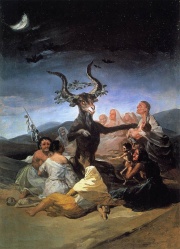Witch
From The Art and Popular Culture Encyclopedia
|
Related e |
|
Featured: |
- A man who practises witchcraft.
- 1485, Sir Thomas Malory, Le Morte Darthur, Book I.8:
- And som of hem lough [Merlin] to scorne, as kyng Lot, and mo other called hym a wytche.
- 1485, Sir Thomas Malory, Le Morte Darthur, Book I.8:
- A woman who is learned in and actively practices witchcraft.
- An ugly or unpleasant woman.
- I hate that old witch.
Contents |
Folklore
Powers typically attributed to European witches include turning food poisonous or inedible, flying on broomsticks or pitchforks, casting spells, cursing people, making livestock ill and crops fail, and creating fear and local chaos.
Flying
In the past, it was believed that witches used a mixture of belladonna, opium poppy, and other plants, typically poisonous (such as monkshood and poison hemlock) in flying ointment they applied to help them fly to gatherings with other witches. Carlo Ginzburg and others have argued that flying ointments were preparations meant to encourage hallucinatory dreaming; a possible explanation for the inclusion of belladonna and opium poppy in flying ointments concerns the known antagonism between tropane alkaloids of belladonna (specifically scopolamine) and opiate alkaloids in the opium poppy, Papaver somniferum (specifically morphine), which produces a dream-like waking state. This antagonism was known in folk medicine, discussed in eclectic (botanical) medicine formularies The antagonism between opiates and tropanes is the original basis of the Twilight Sleep that was provided to Queen Victoria to deaden pain as well as consciousness during childbirth.
Witches in art
Renaissance
- The Four Witches
- Witch Riding on a Goat by Durer
- Hans Baldung Grien's witches
- Depart pour le Sabat by Teniers
18th century
- Witches' Sabbath (1798) by Francisco Goya
19th century
See also


